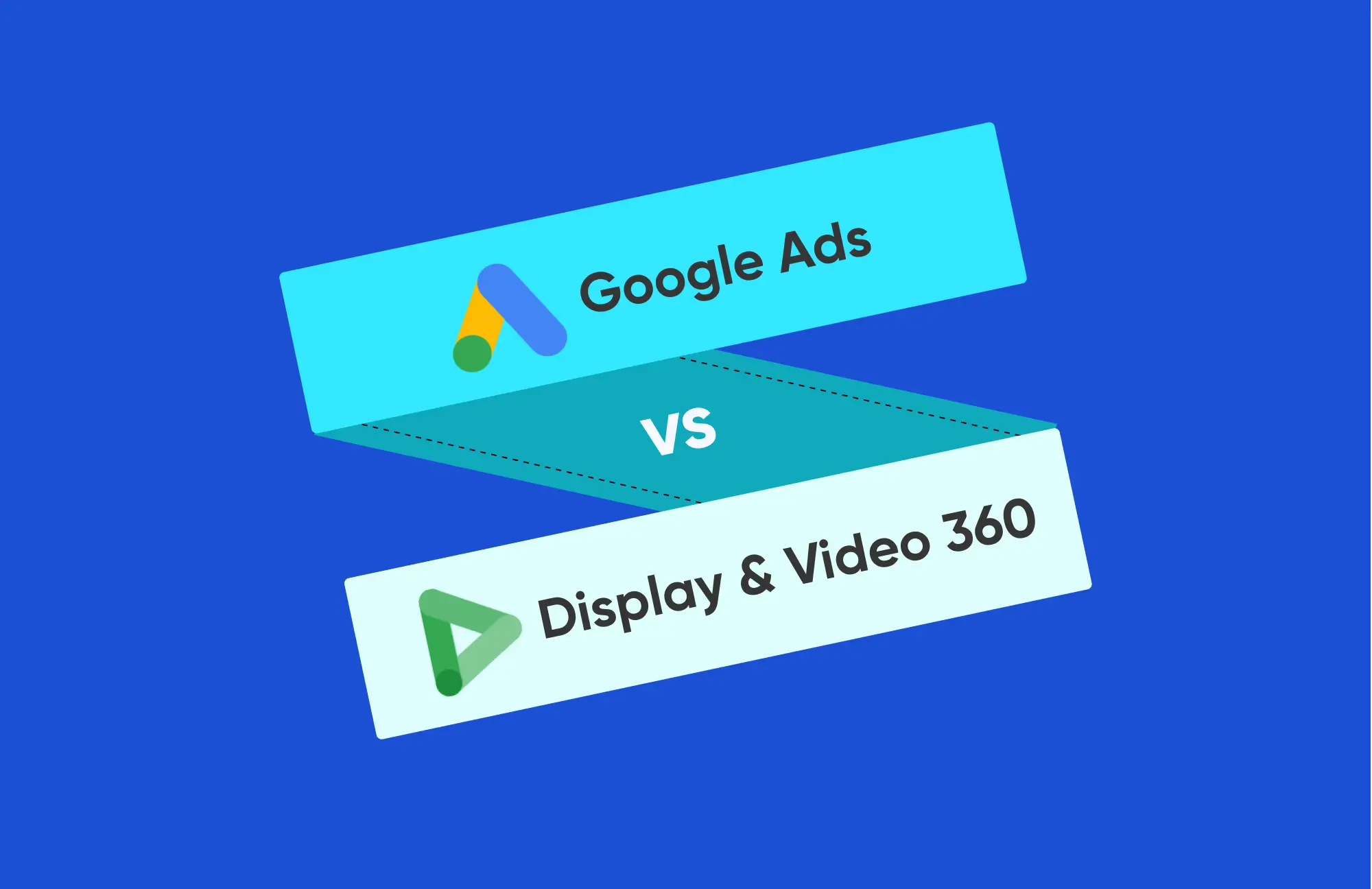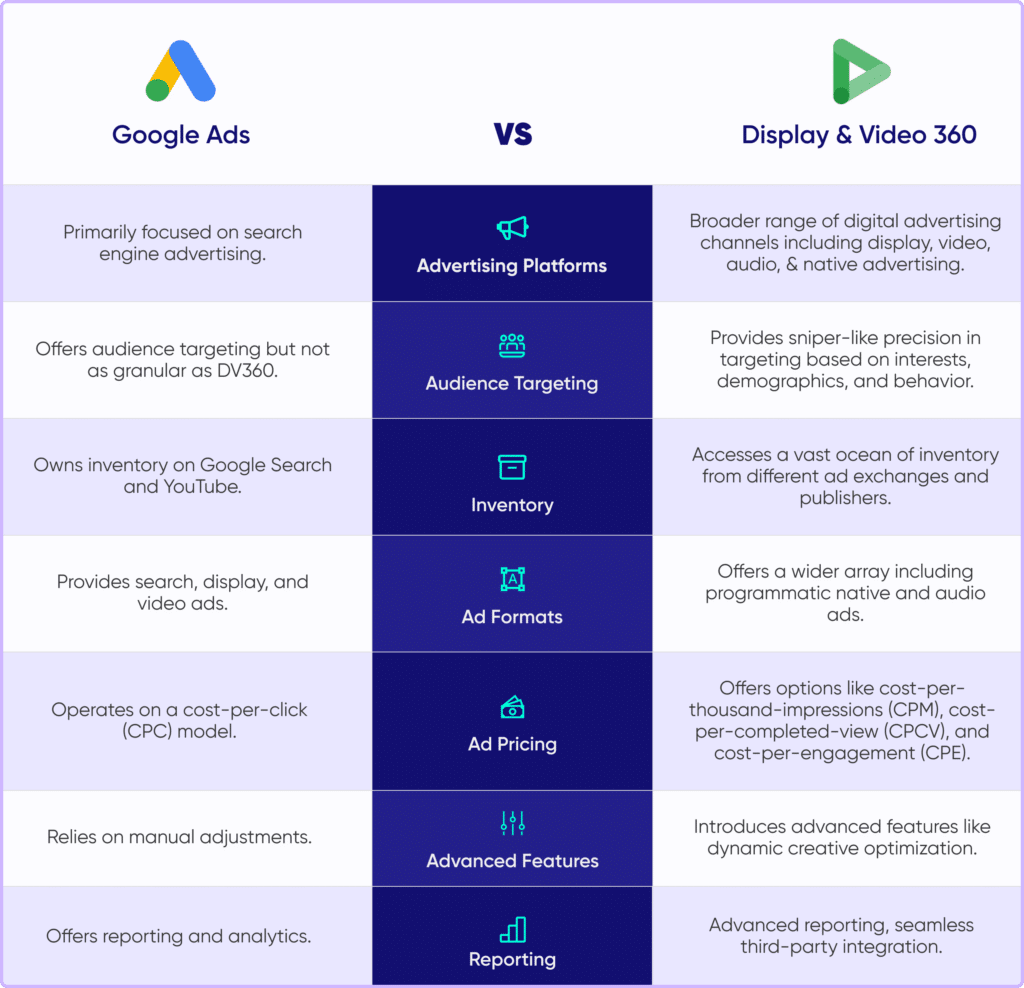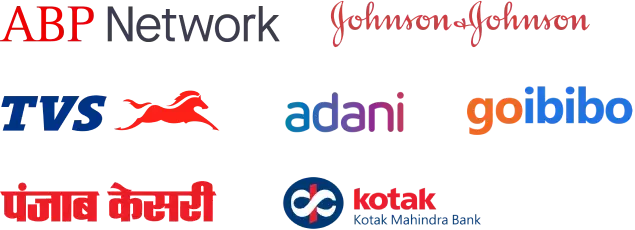There’s constant buzz in the marketing world: Should you invest in Google Ads or level up with Display & Video 360 (DV360)?
Which platform truly fits your business needs?
In today’s ever-evolving digital advertising landscape, businesses must make strategic choices about where and how to invest their media budgets.
Two of the most powerful tools in the Google advertising ecosystem: Google Ads and Display & Video 360 (DV360) which offer distinct advantages depending on your goals, team structure, and marketing maturity.
Let’s delve into the dynamic world of programmatic advertising and explore the unique capabilities of these two formidable platforms. This isn’t just a technical comparison, actually it’s a decision-making framework based on strategy, scale, precision, and sophistication.
Whether you’re a startup seeking fast conversions or an enterprise brand aiming for full-funnel media domination, this guide will help you make an informed, results-driven choice.
So, grab your favorite brew and settle in as we decode DV360 vs Google Ads through the lens of real-world performance, platform depth and expert insights from pioneers like Tatvic, who help brands maximize impact through both platforms.
Difference Between Google Ads and Display & Video 360 (DV360)
Choosing between Google Ads and Display & Video 360 (DV360) depends on your business goals, budget and desired reach.
While Google Ads offers a more straightforward entry into digital advertising and is ideal for quick-to-launch, search-intent campaigns.
Display & Video 360 (DV360) brings enterprise-level programmatic capabilities and expansive inventory access and is built for brands looking to run data-rich, multi-channel strategies at scale.
Understanding the unique strengths of each can help you plan smarter, more effective campaigns.
Below is a detailed comparison to help you decide which platform aligns better with your marketing objectives.
Major Difference Between Google Ads and Display & Video 360 (DV360)
In-Depth Comparison: Google Ads vs DV360 Capabilities Across Targeting, Inventory, Formats and Performance
When evaluating Google Ads vs DV360, it’s essential to look beyond surface-level differences.
This in-depth comparison explores how each platform performs across key dimensions like: audience targeting, ad inventory, creative formats, pricing models and campaign optimization.
Whether you’re scaling a full-funnel programmatic strategy or focusing on search-driven performance, understanding these capabilities will help you choose the right platform.
Backed by Tatvic’s real-world expertise, this guide helps decode which solution fits your business goals best.
Let’s Dive Into Feature-by-Feature Showdown of Google Ads vs DV360
1. Advertising Platforms: Search-Powered Precision vs Multi-Channel Mastery
When it comes to selecting the right digital advertising platform, your brand’s growth trajectory and marketing objectives play a critical role.
Google Ads is often the go-to for businesses looking to capture high-intent audiences at the moment of search.
It shines in performance-driven campaigns where quick conversions and measurable ROI are key.
Core Channels of Google Ads include:
- Google Search: Ideal for capturing demand through keyword-triggered text ads
- Google Display Network (GDN): Great for remarketing and brand awareness through static visuals
- YouTube: Powerful for video storytelling, both skippable and non-skippable formats
On the other side, Display & Video 360 (DV360) which is a part of the Google Marketing Platform (GMP), caters to marketers aiming for scale, sophistication, and full-funnel campaign orchestration.
Google DV360 is built to unify media buying across:
- Programmatic Display
- In-stream and Out-stream Video
- Digital Audio Channels (e.g., Spotify, podcasts)
- Native Advertising across premium publisher sites
- Connected TV (CTV) and OTT platforms
Unlike Google Ads, which is laser-focused on intent and conversion, DV360 empowers brands to build awareness, drive consideration and nurture leads across multiple touchpoints and devices.
Tatvic, a Google-certified partner, enables brands to tap into DV360’s full potential through both managed and self-serve models.
2. Audience Targeting: Practical Reach vs Precision Targeting
Effective advertising starts with reaching the right audience.
Both Google Ads and DV360 offer powerful targeting capabilities, though with very different scopes.
Google Ads provides robust yet practical targeting options for advertisers aiming to capture immediate intent.
Customer Segments Present in Google Ads:
- Demographics (age, gender, household income)
- In-market audiences actively researching products or services
- Custom intent audiences tailored to specific keywords or URLs
- Remarketing to users who have previously interacted with your site or app
These features work well for SMBs and performance marketers focused on lower-funnel conversions and immediate ROAS.
However, DV360 unlocks the next level of audience intelligence by integrating data from across the digital ecosystem, making it a game-changer for enterprise-level personalization and multi-touch campaigns.
With DV360, you can:
- Seamlessly ingest first-party data from GA4, CRM systems or CDPs
- Access third-party data from industry leaders like Oracle, BlueKai and Lotame
- Build lookalike audiences based on your highest-converting users
- Leverage custom affinity segments based on nuanced interests and behaviors
- Activate real-time contextual triggers, such as weather conditions, device usage, location, or even app engagement
The result?
Hyper-personalized advertising that adapts to user context in real time—driving higher engagement, lower cost per acquisition, and better lifetime value.
With Tatvic’s DV360 Managed Services, brands can go beyond basic segmentation to build hyper-personalized programmatic experiences that convert.
3. Inventory Access: Limited Network vs Programmatic Universe
When it comes to digital ad placements, inventory access can make or break your campaign’s reach and performance.
This is where the core difference between Google Ads and Display & Video 360 (DV360) becomes abundantly clear.
Google Ads provides access to a highly effective but relatively limited inventory network that includes:
- Google Search: for keyword-targeted search ads
- Google Display Network (GDN): a vast collection of over 2 million websites and apps
- YouTube: the go-to platform for video advertising
While this network offers solid visibility within the Google ecosystem, it restricts your ability to scale beyond Google’s owned and operated platforms.
DV360, on the other hand, opens the floodgates to a truly programmatic advertising universe.
It enables advertisers to reach audiences across 80+ global ad exchanges, giving you access to inventory that extends far beyond Google’s walled garden.
With DV360, you can get enhanced inventory & secure placements on:
- Premium publishers via Private Marketplace (PMP) deals and Programmatic Guaranteed (PG) campaigns
- Streaming and audio platforms like Spotify, Hulu, and Pandora
- Top-tier media outlets including The New York Times, Forbes, and CNN
- Emerging channels like Connected TV (CTV), Digital Out-of-Home (DOOH), and gaming environments
This breadth of inventory empowers brands to deliver consistent messaging across multiple consumer touchpoints, from mobile and desktop to smart TVs and beyond.
4. Ad Formats: Essentials vs Advanced Creativity
When it comes to grabbing consumer attention, the format of your ad can be just as impactful as the message itself.
Both Google Ads and Display & Video 360 (DV360) offer powerful creative capabilities but the depth and flexibility of those formats vary significantly.
Supported Ad formats in Google Ads :
- Text-based search Ads: ideal for capturing intent on the Google Search Network
- Standard display banners: used across websites within the Google Display Network (GDN)
- YouTube video Ads: including skippable, non-skippable, and bumper formats for awareness or engagement
These formats are highly effective for lower-funnel performance campaigns, where the focus is on driving immediate clicks or conversions based on user intent.
DV360, however, is where creative storytelling meets advanced technology. As part of the Google Marketing Platform, DV360 enables advertisers to build immersive, interactive, and context-aware experiences across a diverse set of channels.
Supported Ad formats in Display & Video 360 (DV360):
- Rich HTML5 creatives – interactive, dynamic, and responsive formats for higher engagement
- Shoppable video ads – turn video into a direct purchase experience by embedding product feeds
- Audio and podcast ads – ideal for reaching users during screen-free moments on platforms like Spotify
- Native ads and immersive mobile formats – seamlessly blend into app environments and content feeds
- Connected TV (CTV) and OTT – deliver cinematic experiences on large screens via smart TVs and streaming devices
This expansive creative suite empowers brands to deliver personalized, cross-device narratives that adapt to where and how their audience is consuming content.
With Tatvic’s DV360 Self-Serve and Managed Services, you also gain access to expert creative consulting, dynamic ad production and real-time performance optimization, ensuring every format is used to its fullest potential.
In short, Google Ads is great for essential outreach, while DV360 is built for brands ready to scale their storytelling across every screen and format.
5. Pricing Models, Bidding & Strategic Flexibility
Budget efficiency is a cornerstone of any successful digital campaign and the pricing model you choose directly impacts your ROI.
Google Ads Bidding or Price Options:
Google Ads offers simplified, Performance-driven Pricing or Bidding Options such as:
- CPC (Cost Per Click): Pay when someone clicks your ad
- CPM (Cost Per Mille): For display impressions, though options are relatively limited
This model is suitable for advertisers focused on immediate, measurable actions like lead generation or eCommerce conversions.
Display & Video 360 (DV 360) Bidding or Price Options:
DV360, on the other hand, unlocks a wider pricing architecture with strategic depth, giving you far greater flexibility to align spend with business goals.
It supports:
- CPM, CPCV (Cost Per Completed View) and CPA (Cost Per Acquisition)
- Viewability-based bidding: Ensure your ads are actually seen
- Dynamic CPM (dCPM): Real-time bid adjustments based on user behavior
- Custom bidding logic powered by BigQuery: Create advanced rules that optimize for KPIs like scroll depth, engaged time, or product interactions
6. Creative Optimization: A/B Testing vs Dynamic Personalization
Great creative drives engagement but what’s even better is creative that evolves with your audience.
Google Ads enables basic creative testing through:
- Responsive search and display ads – Rotate headlines, descriptions, and visuals for automated A/B testing
- Limited personalization capabilities based on device or location
While effective for foundational optimization, this approach lacks deeper dynamic flexibility.
DV360 brings advanced creative personalization to the forefront through:
- Dynamic Creative Optimization (DCO): Automatically customize ads in real-time based on user data
- Rule-based personalization: Tailor content to time of day, device, geographic location, or product availability
- Automated ad variant generation: Integrate with product feeds or CRM data to scale personalized experiences
7. Reporting & Attribution: Basic Analytics vs Unified Insights
When it comes to understanding performance, not all analytics are created equal.
Google Ads Offers Accessible Reporting On:
- Clicks, impressions & conversion rate
- Device performance and basic demographic data
- Primarily relies on last-click attribution, which may not reflect the true path to conversion
DV360, as part of the Google Marketing Platform, offers enterprise-grade measurement and a unified data ecosystem.
Dv360 Offers Reporting On:
- Multi-touch attribution via Campaign Manager 360: Understand the full conversion journey
- Custom data pipelines to BigQuery: For advanced segmentation and predictive analysis
- Visual dashboards through Looker Studio: Monitor KPIs in real-time
- Behavioral insights via GA4: Tie campaigns back to website engagement, scroll depth, or micro-conversions
8. Brand Safety & Transparency Controls
In today’s digital ecosystem, brand trust is non-negotiable.
Ensuring your ads appear in safe, relevant environments is critical to maintaining brand integrity.
Google Ads provides essential safety features like:
- Category and content exclusions
- Basic keyword-level filtering for display ads
However, DV360 raises the bar on brand safety and media transparency with enterprise-grade protections, including:
- Pre-bid brand suitability filters to avoid undesirable inventory before bidding
- Third-party verification integrations with tools like MOAT, IAS, and DoubleVerify
- Site allow/block lists, keyword exclusions, and viewability thresholds
- Compliance enforcement for ads.txt and app-ads.txt to combat domain spoofing
When to Use Which Advertising Platform: Ideal Use Cases
Use Google Ads When:
- You’re focusing on search-driven lead generation
- You have a smaller team or limited programmatic experience
- Your goal is local/regional awareness or lower-funnel conversions
Example:
–> Local Retail Chain needs high-CTR promotions near store locations → Use Google Ads
Use Display & Video 360 (DV 360) When:
- You require multi-channel, large-scale reach
- You want programmatic deals and diverse formats
- Your team wants to optimize for brand + performance KPIs simultaneously
Example:
–> Local Retail Chain needs high-CTR promotions near store locations → Use Google Ads
–> B2B SaaS Firm: Wants IP-based targeting and account-based marketing → Use DV360 PMP Deals + LinkedIn Audiences
Tatvic’s Expertise in Display & Video 360
As a pioneer in DV360 programmatic advertising, Tatvic offers:
- DV360 Self-Serve access for agile internal teams
- Managed DV360 services for brands that require hands-on optimization
- Hybrid execution models where Tatvic leads strategy, and the client’s team executes campaigns
Real Results from Tatvic’s DV360 Deployments:
EdTech Brand: 3.2x higher installs vs Facebook using YouTube + OTT
Luxury Retailer: 5.1x ROAS using PMP + high-income affinity segments
Fintech App: 38% CPA reduction and 2.7x CTR via DCO + GA4 insights
Final Verdict: DV360 vs Google Ads
If your goals are tightly performance-driven with a lean team and budget, Google Ads offers a solid foundation.
If you’re aiming for enterprise-level precision, premium inventory, and deeper insights, Display & Video 360 (DV360) is your best bet.
Google Ads vs Display & Video 360 (DV360): Detailed Comparison
| Aspect | Google Ads | Display & Video 360 (DV360) |
| Ad Inventory Scope | Access is limited to Google-owned properties such as Google Search, YouTube, Google Display Network (GDN), Gmail, and some partner sites. | Offers expansive reach through 80+ premium ad exchanges and SSPs, including non-Google inventory like Hulu, Spotify, The New York Times, and connected TV apps. |
| Targeting Options | Standard targeting features like keywords, location, device type, demographics, and basic custom audiences. | Advanced targeting capabilities: custom affinity, first- and third-party data, contextual targeting, time/weather-based triggers, and predictive modeling using Google Cloud integrations. |
| Ad Formats | Supports core formats: search text ads, responsive display, YouTube video ads, Shopping ads, and app install formats. | Enables high-impact creatives: rich media, audio ads, programmatic native, dynamic creatives, connected TV ads, podcast ads, and shoppable video experiences. |
| Audience Segmentation | Basic audience segmentation using Google’s native insights and user behavior. Retargeting is possible but limited in depth. | Deep segmentation using GA4 integration, CRM onboarding, lookalike modeling, third-party data providers (e.g., BlueKai, Oracle), and sequential storytelling. |
| Campaign Management | Primarily manual with support for Smart Bidding and automation through Performance Max or responsive ad formats. | Highly automated with machine learning-powered optimization, custom bidding algorithms, and centralized campaign management across media types. |
| Cross-Channel Reach | Primarily focuses on Google ecosystems: Search, YouTube, and GDN. | Full-funnel, omnichannel capabilities: run campaigns simultaneously across desktop, mobile, CTV, digital out-of-home (DOOH), audio streaming, and in-app environments. |
| Real-Time Bidding (RTB) | Restricted to auctions within Google’s native ad space. | True programmatic RTB environment across multiple SSPs and DSPs. Also includes access to Private Marketplace (PMP) and Programmatic Guaranteed deals. |
| Programmatic Capabilities | Limited—includes Smart Display and Performance Max campaigns but lacks full customization or deal-based buying. | Enterprise-grade programmatic access with deal-based buying (PG, PMP), integration with DV360 APIs, and custom algorithms via BigQuery. |
| Pricing Models | CPC (Cost Per Click), CPM (Cost Per Mille), CPA (Cost Per Acquisition), CPV (Cost Per View), Maximize Conversions, and Target ROAS. | Offers advanced pricing flexibility: CPM, vCPM, CPCV (Cost Per Completed View), dCPM (Dynamic CPM), Programmatic Guaranteed pricing, and custom bidding strategies. |
| Creative Optimization | Limited A/B testing and ad customization through Responsive Ads. | Supports Dynamic Creative Optimization (DCO) using data feeds, product inventory, real-time triggers, and user behavior to generate hyper-relevant ads. |
| Reporting & Attribution | Standard performance reporting with Google Ads dashboard. Attribution often based on last-click model or simplified conversion paths. | Offers robust reporting via Campaign Manager 360, BigQuery, GA4, and Looker Studio. Enables multi-touch attribution (MTA) and custom data pipelines for deep analytics. |
| Brand Safety & Compliance | Basic controls—category exclusions, placement blocking, and limited fraud detection. | Enterprise-grade brand safety: pre-bid verification, integrations with IAS, MOAT, and DoubleVerify, site list curation, viewability thresholds, and ads.txt enforcement. |
| Best Suited For | Small to mid-sized businesses focused on intent-based marketing, search advertising, and quick performance visibility within Google’s environment. | Large-scale advertisers, enterprise brands, and agencies looking for multi-channel media buying, deeper data integration, programmatic control, and creative flexibility. |
Still uncertain?
With over a decade of programmatic experience, we’ll help you unlock the full power of DV360 on your terms.




